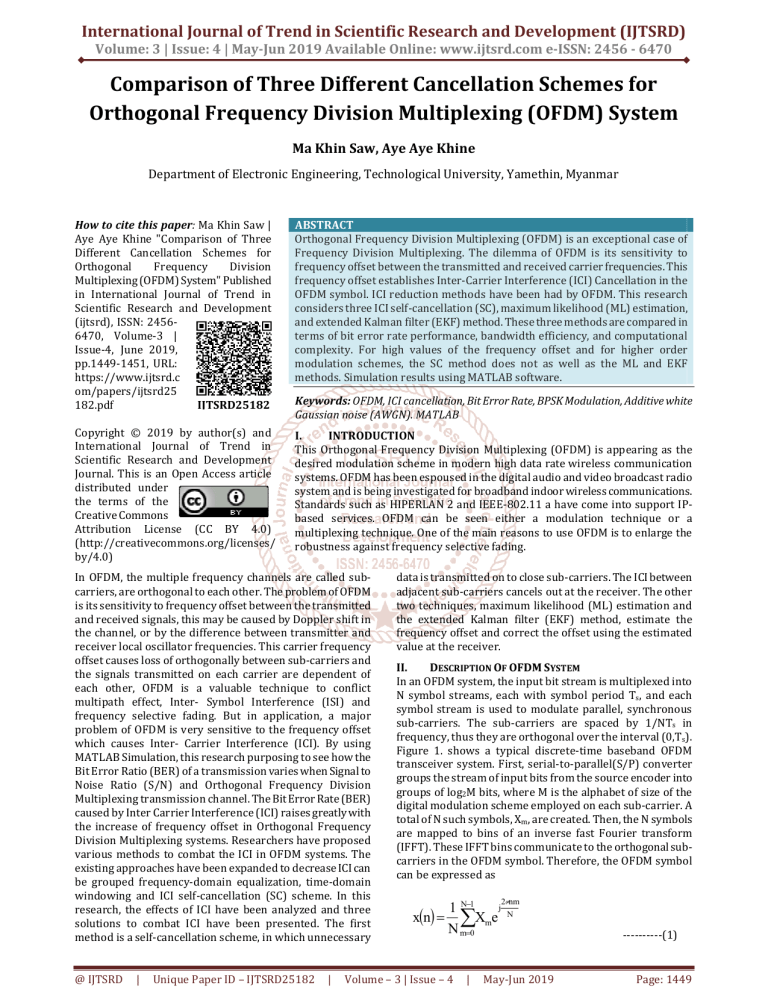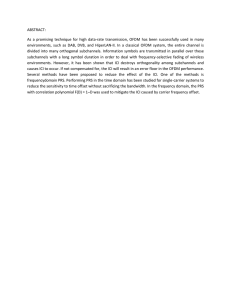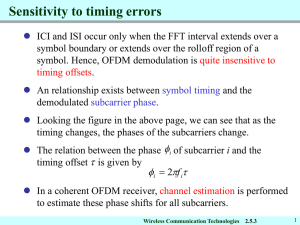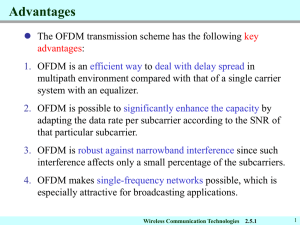
International Journal of Trend in Scientific Research and Development (IJTSRD)
Volume: 3 | Issue: 4 | May-Jun 2019 Available Online: www.ijtsrd.com e-ISSN: 2456 - 6470
Comparison of Three Different Cancellation Schemes for
Orthogonal Frequency Division Multiplexing (OFDM) System
Ma Khin Saw, Aye Aye Khine
Department of Electronic Engineering, Technological University, Yamethin, Myanmar
How to cite this paper: Ma Khin Saw |
Aye Aye Khine "Comparison of Three
Different Cancellation Schemes for
Orthogonal
Frequency
Division
Multiplexing (OFDM) System" Published
in International Journal of Trend in
Scientific Research and Development
(ijtsrd), ISSN: 24566470, Volume-3 |
Issue-4, June 2019,
pp.1449-1451, URL:
https://www.ijtsrd.c
om/papers/ijtsrd25
182.pdf
IJTSRD25182
ABSTRACT
Orthogonal Frequency Division Multiplexing (OFDM) is an exceptional case of
Frequency Division Multiplexing. The dilemma of OFDM is its sensitivity to
frequency offset between the transmitted and received carrier frequencies. This
frequency offset establishes Inter-Carrier Interference (ICI) Cancellation in the
OFDM symbol. ICI reduction methods have been had by OFDM. This research
considers three ICI self-cancellation (SC), maximum likelihood (ML) estimation,
and extended Kalman filter (EKF) method. These three methods are compared in
terms of bit error rate performance, bandwidth efficiency, and computational
complexity. For high values of the frequency offset and for higher order
modulation schemes, the SC method does not as well as the ML and EKF
methods. Simulation results using MATLAB software.
Copyright © 2019 by author(s) and
International Journal of Trend in
Scientific Research and Development
Journal. This is an Open Access article
distributed under
the terms of the
Creative Commons
Attribution License (CC BY 4.0)
(http://creativecommons.org/licenses/
by/4.0)
I.
INTRODUCTION
This Orthogonal Frequency Division Multiplexing (OFDM) is appearing as the
desired modulation scheme in modern high data rate wireless communication
systems. OFDM has been espoused in the digital audio and video broadcast radio
system and is being investigated for broadband indoor wireless communications.
Standards such as HIPERLAN 2 and IEEE-802.11 a have come into support IPbased services. OFDM can be seen either a modulation technique or a
multiplexing technique. One of the main reasons to use OFDM is to enlarge the
robustness against frequency selective fading.
Keywords: OFDM, ICI cancellation, Bit Error Rate, BPSK Modulation, Additive white
Gaussian noise (AWGN). MATLAB
In OFDM, the multiple frequency channels are called subcarriers, are orthogonal to each other. The problem of OFDM
is its sensitivity to frequency offset between the transmitted
and received signals, this may be caused by Doppler shift in
the channel, or by the difference between transmitter and
receiver local oscillator frequencies. This carrier frequency
offset causes loss of orthogonally between sub-carriers and
the signals transmitted on each carrier are dependent of
each other, OFDM is a valuable technique to conflict
multipath effect, Inter- Symbol Interference (ISI) and
frequency selective fading. But in application, a major
problem of OFDM is very sensitive to the frequency offset
which causes Inter- Carrier Interference (ICI). By using
MATLAB Simulation, this research purposing to see how the
Bit Error Ratio (BER) of a transmission varies when Signal to
Noise Ratio (S/N) and Orthogonal Frequency Division
Multiplexing transmission channel. The Bit Error Rate (BER)
caused by Inter Carrier Interference (ICI) raises greatly with
the increase of frequency offset in Orthogonal Frequency
Division Multiplexing systems. Researchers have proposed
various methods to combat the ICI in OFDM systems. The
existing approaches have been expanded to decrease ICI can
be grouped frequency-domain equalization, time-domain
windowing and ICI self-cancellation (SC) scheme. In this
research, the effects of ICI have been analyzed and three
solutions to combat ICI have been presented. The first
method is a self-cancellation scheme, in which unnecessary
@ IJTSRD
|
Unique Paper ID – IJTSRD25182
|
data is transmitted on to close sub-carriers. The ICI between
adjacent sub-carriers cancels out at the receiver. The other
two techniques, maximum likelihood (ML) estimation and
the extended Kalman filter (EKF) method, estimate the
frequency offset and correct the offset using the estimated
value at the receiver.
II.
DESCRIPTION OF OFDM SYSTEM
In an OFDM system, the input bit stream is multiplexed into
N symbol streams, each with symbol period Ts, and each
symbol stream is used to modulate parallel, synchronous
sub-carriers. The sub-carriers are spaced by 1/NTs in
frequency, thus they are orthogonal over the interval (0,Ts).
Figure 1. shows a typical discrete-time baseband OFDM
transceiver system. First, serial-to-parallel(S/P) converter
groups the stream of input bits from the source encoder into
groups of log2M bits, where M is the alphabet of size of the
digital modulation scheme employed on each sub-carrier. A
total of N such symbols, Xm, are created. Then, the N symbols
are mapped to bins of an inverse fast Fourier transform
(IFFT). These IFFT bins communicate to the orthogonal subcarriers in the OFDM symbol. Therefore, the OFDM symbol
can be expressed as
x(n) =
j
1 N−1
Xme
∑
N m=0
Volume – 3 | Issue – 4
|
2πnm
N
May-Jun 2019
----------(1)
Page: 1449
International Journal of Trend in Scientific Research and Development (IJTSRD) @ www.ijtsrd.com eISSN: 2456-6470
where the Xm's are the baseband symbols on each subcarrier. The digital-to-analog (D/A) converter then creates
an analog time-domain signal which is transmitted through
the channel.
At the receiver, the signal is converted back to a discrete N
point sequence y(n), corresponding to each sub-carrier. This
discrete signal is demodulated using and N point fast Fourier
transform (FFT) operation at the receiver. The demodulated
symbol stream is given by:
N−1
Y(m) = ∑y(n)e
m=0
-j
2πnm
N
+ W(m)
---------(2)
where, W (m) corresponds to the FFT of the sample of w(n),
which is the Additive White Gaussian Noise (AWGN)
introduced in the channel.
Figure1. Baseband OFDM transceiver system
III.
COMPARISON OF THREE DIFFERENT CANCELLATION
SCHEMES
To compare the three different cancellation schemes, BER
curves were used to evaluate the performance of each
scheme. By using MATLAB simulation, the results are
expressed in this research. The OFDM transceiver system
was implemented as specified by figure 1. Modulation
schemes of binary phase shift keying (BPSK) and 4-ary
quadrature amplitude modulation (QAM) were chosen
because they are used in many standards such as 802.11a.
The normalized frequency offsets of simulations equal to
0.05, 0.15, and 0.30 are given in figure 2(a) and (b).
Figure2 (b) BER performance of a standard OFDM system
without ICI cancellation for 4-QAM
These results show that debasement of performance
increases with frequency offset. In case of binary phase shift
keying, the frequency offset of 0.30 does not get worse the
performance too greatly. When frequency offset is small, the
4-QAM system has a lower BER than the BPSK system. But
the BER of BPSK diverse more dramatically with the
decrease the frequency offset than that of 4-QAM. Therefore,
it is terminated that larger alphabet sizes are more sensitive
to ICI. The comparisons of performance of the SC, ML and
EKF schemes for different alphabet sizes and different values
of the frequency offset show in figure 3(a) and (b). It is
examined in the figures that each method has its own
advantages. The presence of small frequency offset and
binary alphabet size, self-cancellation gives the best results.
Although, for larger alphabet sizes and larger frequency
offset such as 4- QAM and frequency offset of 0.05, self
cancellation offers much decrease in performance. The best
overall results are given by the maximum likelihood method.
The Kalman filter method indicates that for very small
frequency offset, it performs very badly, as it barely
improves BER. However, for high frequency offset the
Kalman filter does perform extremely well. It gives a
significant high to performance.
Figure3 (a) BER Performance with ICI Cancellation, ε =
0.05 for BPSK
Figure2 (a) BER performance of a standard OFDM
system without ICI cancellation for BPSK.
@ IJTSRD
|
Unique Paper ID – IJTSRD25182
|
Volume – 3 | Issue – 4
|
May-Jun 2019
Page: 1450
International Journal of Trend in Scientific Research and Development (IJTSRD) @ www.ijtsrd.com eISSN: 2456-6470
sent before the data symbols for estimation of the
frequency offset. Also, the case of self cancellation modified
self cancellation and maximum likelihood methods. In these
methods, bandwidth efficiency is reduced. To use a
particular Inter-carrier Interference reduction method in
OFDM system. There must be a tradeoff between
bandwidth efficiency and bit error rate.
Figure3 (b) BER Performance with ICI Cancellation, ε =
0.05 for 4-QAM.
For small alphabet sizes (BPSK) and for low frequency offset
values, the SC and ML techniques have good performance in
terms of BER. However, the EKF and ML techniques perform
better are higher order modulation schemes. The ML and
EKF methods estimate the frequency offset very precisely
and cancel the offset using this estimated value. However,
the self-cancellation technique does not absolutely cancel the
ICI from adjacent sub-carriers. The effect of this residual ICI
increases for larger alphabet sizes and offset values.
IV.
CONCLUSION
In this research, orthogonal frequency division multiplexing
comes out to be a good modulation technique for high
performance wireless communications. Between the
transmitter and receiver, the performance of OFDM systems
in the presence of frequency offset has been studied in terms
of the bit (BER) performance and Carrier-to-Interference
ratio. Inter-carrier Interference (ICI) which results from the
frequency offset corrupts the performance of the OFDM
system.
Three methods were discovered in this research for lessen of
the ICI. The ICI self-cancellation (SC) and the maximum
likelihood (ML) estimation techniques were proposed in
prior publications. In this research, the extended Kalman
filtering (EKF) method for estimation and cancellation of the
frequency offset has been investigated, and compared with
the SC and ML techniques. The choice of which method to
employ depends on the specific application. Self-cancellation
(SC) does not require very complex hardware or software for
implementation. The ML method also introduces the same
level of redundancy but provides better BER performance.
As it accurately estimates the frequency offset. Its
implementation is more complex than the SC method. On the
other hand, the EKF method does not reduce bandwidth
efficiency as the frequency offset can be estimated from the
preamble of the data sequence in each OFDM frame. OFDM
has the most complex implementation of the three methods.
Moreover, this method requires a training sequence to be
@ IJTSRD
|
Unique Paper ID – IJTSRD25182
|
ACKNOWLEDGMENT
First of all, the authors would like to express their special
thanks to Dr. Myo Thein Gyi, Union Minister of Education, the
Republic of the Union of Myanmar, for his encouragement to
do research works for regional development and applied
science. The authors’ grateful thanks go to Dr. Khin Maung
Chin, Acting Pro-Rector and Principal of Technological
University (Yamethin) for his kind guidance, suggestion and
directions throughout the preparation of research work, and
valued motivations and encouragement as well. Finally, the
author is also sincerely thankful to our colleagues from the
Department of Electronic Engineering, Technological
University (Yamethin) offered strong moral and physical
support.
REFERENCES
[1] Wireless LAN Medium Access Control (MAC)and
physical layer (PHY) Specification, IEEE Standard,
Supplement to standard 802 Part II, Wireless LAN, New
York, NY, 1999.
[2] Performance of orthogonal frequency division
multiplexing (OFDM) under the effect of wireless
transmission system drawbacks Sudan Engineering
Society Journal, September 2007.
[3] Yi Sun, “Bandwidth-Efficient Wireless OFDM,” IEEE,
November 2001.
[4] B. G Evans and K. Baughan, “Vision of 4G.” Electronics &
Communication Engineering Journal, December 2000.
[5] P. H. Moose, “A Technical for Orthogonal Frequency
Division Multiplexing Frequency Offset Correction,”
IEEE Transactions on Communication, vol.42, no.10,
October 1994.
[6] A. J. Coulson, “Maximum likelihood synchronization for
ofdm using a pilot symbols: analysis,” IEEE Journal on
Selected Areas in Communications, vol. 19. No 12. Pp.
2495- 2503, 2001.
[7] H. G. Ryu, Y. Li, and J. S Park, “An improved ici reduction
method in ofdm communication system,” IEEE
Transactions on Broadcasting, vol. 51, pp.395-400,
September 2005.
Volume – 3 | Issue – 4
|
May-Jun 2019
Page: 1451





